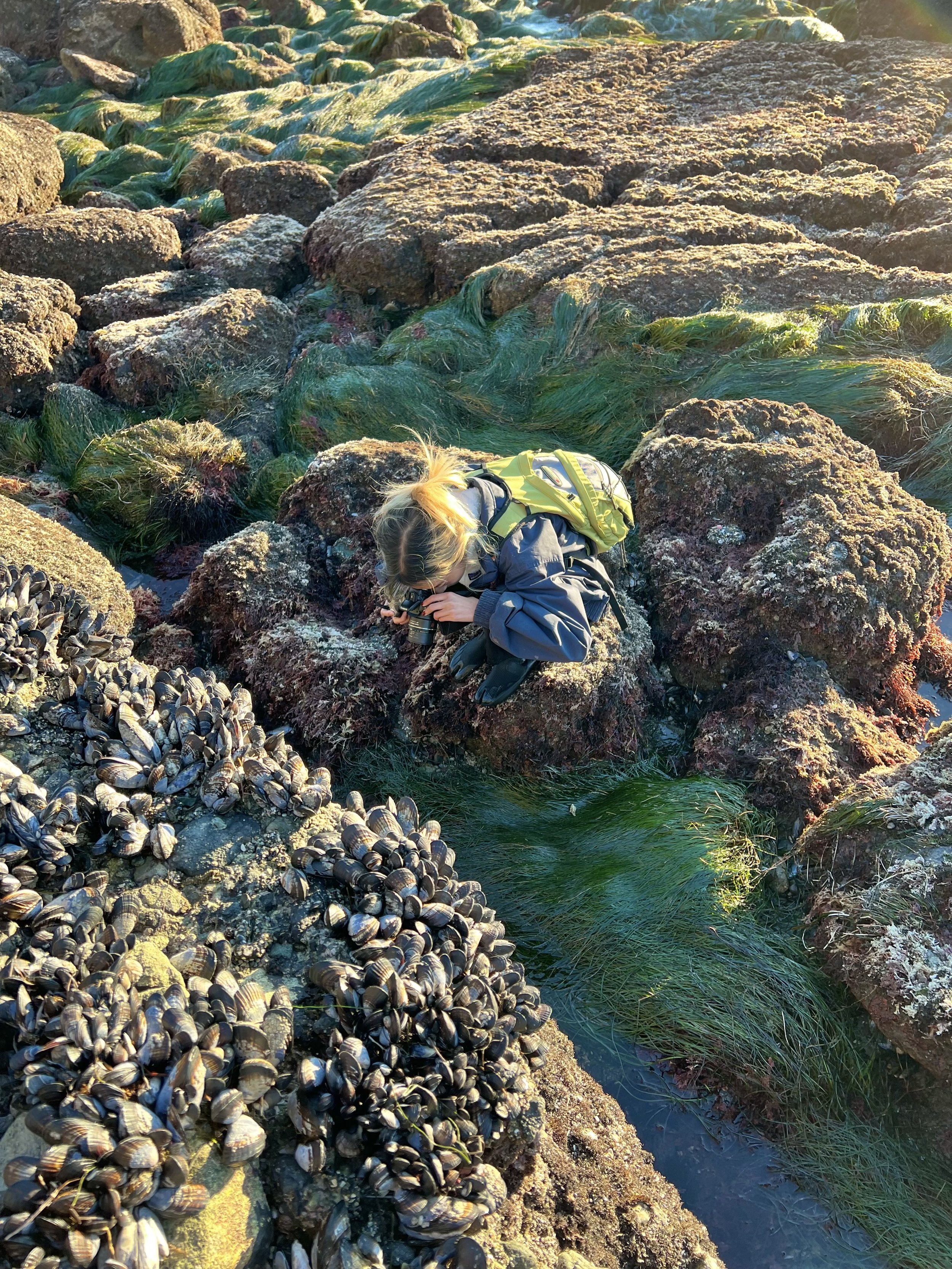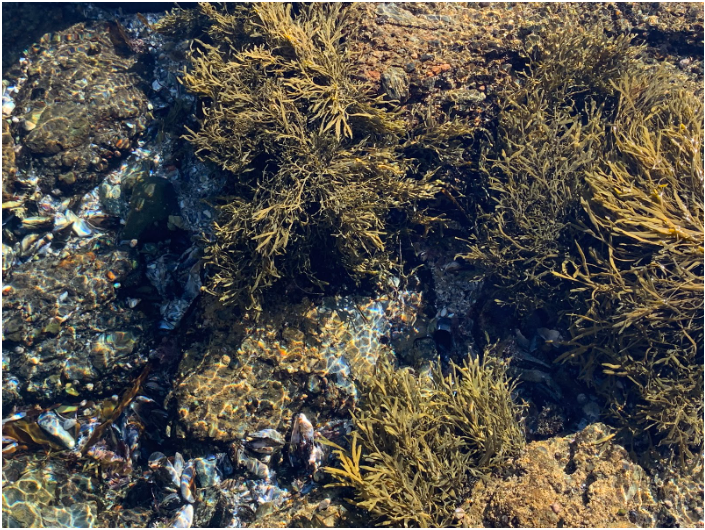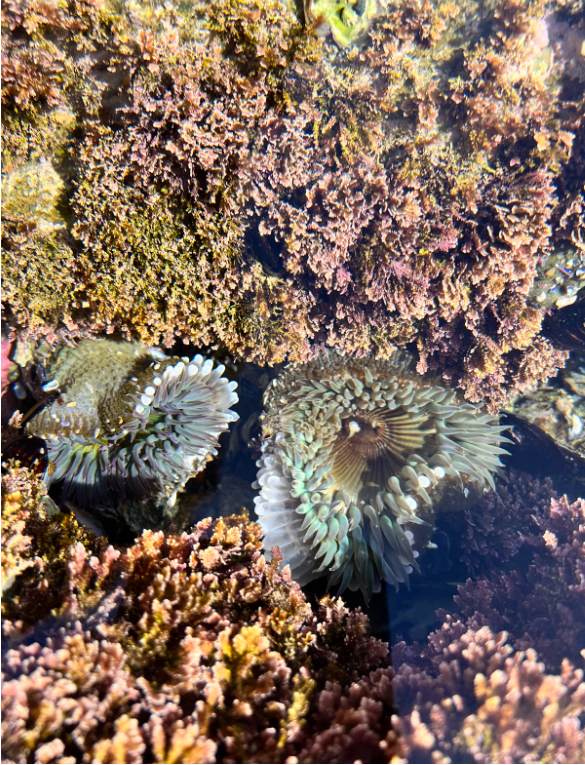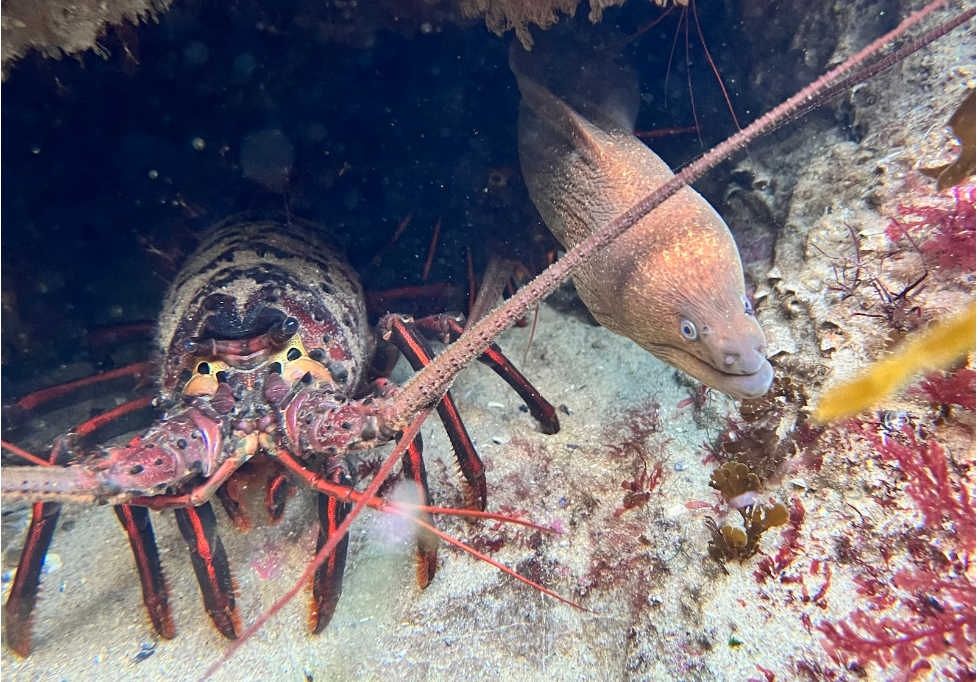Kellie Cabal’s
Ultimate Tidepool Guide
Kellie Cabal
I am a first year marine biology student from Dana Point, California- I’ve been earning credits towards my degree since my junior year of high school! I have a passion for studying all of the life that has the privilege of calling the ocean home and protecting the ocean because it gives us our biggest gift: life! I love all marine life from the microfauna to the megafauna, but have a special interest in shark & ray research and octopus. I also have a blooming interest in zoology! I have gained many skills through various marine science related experience like data collection, use of research equipment, education, organism identification and more! In my free time I love to tide pool, surf, rock climb, read about the ocean and do anything in nature.
Ever since I was a little girl, I’ve been visiting the tide pools around Laguna Beach, thanks to my dad. He’s a big part of where my love for marine science started to bloom. He’d always put Animal Planet or National Geographic on TV, buy me books about animals, and would get me little animal figurines. Every summer, my family and I would visit Monterey Bay, and I would go to The Aquarium Of The Pacific with my dad. It feels like his love of animals and science got passed down to me. Going to the beach was fun not only because it was the beach but because I got to see marine animals in the tidepools.
“When I was younger, a group of kids were repeatedly throwing a shore crab onto this rock and piling sand on top of it. I was probably seven or eight, and they had to be almost teenagers. I went over to them, told them that they were hurting the crab, and put the crab back into a pool far away from the kids.”
After that incident, I knew I was ready to stand up for marine life. Tide pools held a special place in my heart and so did all of the creatures in it. I’ve always known from a young age that I wanted to protect the ocean. From being a mini tide pool enthusiast to a grown, marine biology student who goes tide pooling as a professional job, I’ve learned a lot of tips and tricks along the way from mentors, fellow tide poolers and my own observations! If I didn’t learn from others I don’t know where I would be, so now I want to continue to spread my knowledge with other people who are curious about tide pool ecology!
Laguna Beach
WHAT ARE TIDEPOOLS?
Tidepools are very diverse ecosystems that form in small, isolated pools of water on the rocky shore. Tidepools are constantly being covered and then uncovered by waves during high and low tides. These ecosystems support a vast amount of marine life, especially invertebrates and various algaes. The area where all this marine life flourishes is called the intertidal zone. Tidepool environments are facing constant fluctuations, like change in temperature, exposure to the sun, salinity, wave force and more. Within the intertidal zone, there is the spray zone, upper intertidal zone, mid-intertidal zone and the low intertidal zone. The spray zone is usually always dry and has the most exposure to the air and sun. As we go lower from the upper intertidal zone down to the low intertidal zone, the less exposure there is to the atmosphere meaning the species become less tolerable of such circumstances.
PROTECTING TIDEPOOLS
Part of my role as a tidepool educator with the Laguna Ocean Foundation includes upholding and protecting the health of the tide pools. Tide pools are a part of Marine Protected Areas (MPAs), which have strict protective regulations and limitations on human activity in order to maintain healthy environments and restore environments under duress. A marine protected area is what a national park would be, except for oceanic, aquatic and estuarine ecosystems. Marine protected areas are put in place to instill curiosity + education, protect biodiversity and promote conservation by restricting human impact on these areas. Each MPA’s rules vary, but they all work to protect animal populations, prohibit and/or limit disturbance to the ecosystem like fishing, drilling, restoring endangered species, recreational collecting and more.
TIDE POOL DO’S AND DON'Ts
Because life in the tidepools is highly protected, we must remain respectful and observe with thoughtfulness and regard to who’s territory we are stepping into. As curiosity-inspiring as marine life is, the best way to show that we truly care for and appreciate life in the tidepools is by doing what we can to observe in a manner that not only keeps yourself safe, but also the plants and animals that you come across.
DON’T TAKE anything from the tidepools. It seems harmless to take something so small in such a vast environment, but when you have thousands of people coming in and doing the same thing as you, it doesn’t just become one shell that’s taken, but probably double the amount of visitors that pass by. Hermit crabs outgrow their shells and need to look for a new one to fit into. In certain places, there are shell shortages due to too many being taken as souvenirs. Sea anemones use shell bits to cover themselves for protection. Sessile animals like barnacles, bryozoan worms, tunicates, tube worms will grow onto shells and rocks. Shells are very pretty and I also love looking at them! Picking up empty shells is ok as long as we are putting them back. Taking home live organisms not only affects the organism itself, but also the species that feed on it and that it feeds on.
DON’T TOUCH Feeling, poking and prodding are highly discouraged and prohibited. Our skin contains oils and bacterias that are harmful to marine life. Fish especially have a protective layer of mucus covering their body and by touching them, we are removing that layer and making them more prone to sickness. Picking up animals can disorient them and stress them out. The reason that sea anemone tentacles stick to you is because their nematocysts are shooting little harpoon-like needles into you. They need these to hunt their prey, and by touching them you are disrupting their cycle, not to mention the middle of a sea anemone is their mouths! They are sensitive there and it hurts if you poke them. A lot of invertebrates like sea stars, urchins and more have little tube feet that attach to rocks. Ripping them off can damage and hurt their tube feet.
DON’T RUN or TRAMPLE! A lot of tide pool creatures are extremely tiny and fragile. Luckily, barnacles and mussels are the hardier ones, but trampling and running can and will still harm them. There are also animals living under piles of algae. I have found nudibranchs, bat stars, kelpfish, sea snails and hermit crabs from sifting through the algae that I definitely would have stepped on if I hadn’t known they were there. Also, there are certain algaes like rockweed that have reproductive glands in their blades. Stepping on them could pop those glands.
DON’T TURN your back to the ocean. Waves are unpredictable. Be safe!
DON’T HARASS marine life. Marine mammals such as seals and sea lions are just as timid and scared as we are, except they are wild animals and they can and will protect themselves. By touching seals and sea lions, you are gaining entertainment at the cost of their comfort. You can stress them out and this can trigger a negative reaction from them like attacking or biting you. If this were to happen, it is likely that they will get put down due to your ignorance not to mention you could be severely injured. Seals and sea lions also use tidepools to rest their young, and they need to bask and sleep for a certain amount of time and we don’t want to disturb them. I once had a couple come take pictures with the seals after being told not to. They got their cool pictures and the seals showed signs of stress. The seals had to end up flushing (leaving the rocks) and their nap was interrupted. Let nature be and enjoy from a distance. Feeding marine life can be harmful as well. Feeding birds can make them ill, and feeding any animal at all can make them used to human interaction which can put them in danger of exposure to humans or loss of natural instinct like hunting.
DO HAVE PATIENCE For the best tide pooling results, sit at a pool and just watch. The longer you sit and watch, the more you will see start to move. When you first crouch down to a pool, you’ll likely spook all the animals that you don’t see and they’ll freeze and hide. The longer you wait, the more you’ll start to see things start to move around that you will generally miss at first glance.
DO SHARE your knowledge with other people! Even when I’m tidepooling outside of work, I like to tell people that I’m near what they’re looking at, why you can’t touch this animal or why this animal is doing this and so on and so forth. It’s how I learned a lot of the things I know! It also invites curiosity and creates a safe environment for everyone!
DO BEWARE of seaweed. It is VERY slippery! Especially sea lettuce and rockweed. Watch where you step and be sure to use both your hands and feet when climbing around.
DO LOG your finds & discover new species! You can use iNaturalist to log all your finds and you can use Seek by iNaturalist to help you identify plant and animal species. It’s how I discovered species that I didn’t know the names of!
DO stay 150 feet away from seals and sea lions. We are walking into their territory and they need to be respected. They are protected under the Marine Mammal Care Act. It is against the law to harass them.
DO take lots of photos! Although we can’t collect or touch, photos are a great way to remember all the creatures you come across forever while being respectful and safe.
DO look at more than just the tidepools. Look out into the ocean. If you’re patient and lucky enough, you may see a pod of dolphins or even a whale blowing its blowhole. They blow about 3-5 times in 15-20 second intervals.
PREPARING FOR THE TIDES
To choose the best day to go by using a tide chart or app. You can look up the tide chart for your area and the date or you can get an app! I use Tide Chart by Tides, Weather and Radar Near Me. It will tell you when and what time the lowest tide is for your chosen location.
Going at low tide is the best time because that’s when the tide pools are most uncovered by the waves. Lowtide under 2 feet is good, but anything in the negatives is best. If there is a tide in the negatives, definitely take advantage of it! You can see some of the coolest things.
You want to aim to be there an hour or so before peak low tide.
PROPER ATTIRE
Since getting my job as a tidepool educator with Laguna Ocean Foundation, I’ve been constantly evolving my tidepool outfit to curate the most comfortable and efficient get-up to use when tidepooling. A big thing for me when tidepooling is making sure that I’m as comfortable as can be or else it won’t be much fun.
SHIRTS it honestly doesn’t really matter what shirt you wear. On a colder day, I’ll wear a shirt with a long sleeve under. On a hotter day, I’ll wear a tank top.
PANTS To me, pants are one of the clothing items I think are the most important. You’re bound to get wet if you’re tide pooling and I hate the feeling of having wet pants whether it be jeans or leggings but sometimes it’s just too cold to wear shorts to avoid that problem. I bought a pair of water resistant rain pants from REI and they are by far the best pair of pants I've decided to use for tidepooling. They’re thin enough to wear on a hot day, but they still cover my whole legs on cooler days. I’m able to get the bottom of my pant legs wet and they dry very quickly since they’re water resistant!
LAYERS On hot days, I’ll just wear a windbreaker but on cold days, I like to wear a hoodie with a shirt under it and over it with a windbreaker OR a shirt with a warm vest and a windbreaker over it.
SHOES are another important one. Never go to the tidepools with sandals / flip-flops / barefoot. You will be in a lot of pain and you’ll probably only tidepool for about 5 minutes before giving up. Tennis shoes are a fine option but I personally don’t like the feeling of my socks and shoes getting wet. Water shoes will be your most comfortable and affordable option. If you really want to splurge, wetsuit booties have been my BEST option so far! I was very comfortable, my feet stayed completely dry and warm and it was a little more grippy and I didn’t slip as much. Although, there is no hard sole so it hurts to walk around. I would recommend getting water shoes to wear over the booties. Rain Boots are another really great option that have a sole and also keep your feet completely dry and warm!
HAIR if you have long hair, definitely bring a clip or hair tie. I also find it useful to pin my bangs back or wear a headband so that they’re not in my face when I’m looking under rocks or taking photos. There have been many instances where a strand or two of my hair ruined a good picture of an animal..
Outfit and Gear
GEAR
Here are some things I find useful to bring!
A photography camera, if you have one
A clip on macro lens for your phone
A gopro, underwater camera or underwater housing for your phone.
Binoculars. I don’t use them much, but I’ve been able to see whales, dolphins, birds and other marine mammals with them!
A field guide in accordance with your area, The Beachcomber’s Guide to Seashore Life of Southern California by J. Duane Sept is a good one!
I use a High Sierra backpack to carry all of this in!
GETTING GOOD SHOTS
For larger animals like birds and pinnipeds, I use a digital camera.
For underwater photos and videos, I use my phone if it’s not a deep pool and my gopro if it is a deeper pool. There is underwater housing available for your phones too if that’s something that interests you!
For normal phone pictures, I make sure I put my phone as close to the water as possible, just right above it before my phone touches the water so that all the glare in the background isn’t in the photograph. This makes the lighting look good, the quality appear better and the animal clearer to see
CHANGING CONDITIONS
Because tidepools are susceptible to a changing environment, most of the life living in these tidepools have special adaptations to better survive in such unpredictable and harsh conditions.
For example, sea stars and sea urchins have little tube feet that help them grip tightly onto rocks and substrate so that they can latch on to rocks to tolerate the pounding of waves. These tube feet are also what they use to move around! Sea stars and sea urchins are related, they are both Echinoderms from the phylum Echinodermata. Echinoderm means “spiny skinned”. Sea cucumbers, sand dollars and brittle stars are also echinoderms.
THINGS YOU MIGHT SEE
Here are some of my finds! In order from more common to least common in my opinion! All photos taken by me.
California mussels | Mytilus californianus (black, brown and blue)
Gooseneck barnacles | Pollicipes polymerus (tan)
These guys pack together tightly to prevent desiccation. They are pretty resilient and can be out of water for a while.
Sunburst Anemone | Anthopleura sola
Sometimes, when an anemone is fighting a nearby anemone these white, sac-like structures come out. They are called Acrorhagi and they are territory stingers used for intraspecific combat.
Conspicuous Chiton | Stenoplax conspicua
Chitons are usually extremely attached to rocks. Unfortunately, I found this guy floating in the water upside down. This could be a sign of high stress.
Owl Limpet | Lottia gigantea
Owl limpets are territorial and are heavily researched. They are also very often illegally harvested which puts their population at risk.
Aggregating Anemone | Anthopleura elegantissima
These guys are typically found in large groups. When closed up, they just look like a bunch of shells. Be mindful of where you step because those are actually closed up sea anemones!
Opaleye | Girella nigricans
These fish are great and easy to identify because of the white dot on their back!
Striped Shore Crab | Pachygrapsus crassipes
There are three images in the carousel above! Watch as they reveal themselves, or click to the right hand side of the carousel to explore the photos yourself!
(From left)
Rockweed | Silvetia spp: This is the seaweed with reproductive organs in its blades.
Tidepool Sculpin | Oligocottus maculosus: These guys camouflage really well. If you sit and wait you’re likely to see one move.
Sandcastle Worms | Phragmatopoma californica
Purple Sea Urchin | Strongylocentrotus purpuratus
Giant Kelp | Macrocystis pyrifera
Wavy Turban Snail | Megastraea undosa: Hermit crabs also like to inhabit these shells when they’re empty!
California Sea Hare | Aplysia californica
Some of the CUTEST guys you’ll see in the tidepools.
Ochre Star | Pisaster ochraceus
Finding sea stars is a treasure these days. In 2013, “sea star wasting disease” came about and wiped out a large portion of the Pacific coast’s sea stars. Their population is slowly starting to recover and come back!
Spanish Shawl Nudibranch | Flabellinopsis iodinea
Opalescent Nudibranch | Hermissenda opalescens
Hopkin’s Rose Nudibranch | Okenia rosacea
Red Sponge Dorid | Rostanga pulchra
(Right to Left)
Solander’s trivia | Pusula solandri
Great Egret | Ardea alba: Eating a kelpfish! Great egrets can be confused with snowy egrets. Snowy egrets are much smaller and have yellow feet.
Spiny Brittle Star | Ophiothrix spiculata
Panama Serpent Star | Ophioderma Panamense
Bat Star | Patiria miniata
By The Wind Sailor | Velella velella
Baby Bubble Snail | Haminoea Japonica
Adult Bubble Snail | Haminoea Japonica
King Tide Finds
California Two-Spot Octopus | Octopus bimaculoides
*King Tide find!*
The best way to find an octopus is to go to a pool with lots of hiding places, sit still and wait. The best indicator to look for is their siphon opening and closing up.
Abalone (various colors) | Haliotis spp.
*King Tide find!*
This is a very special find! Abalone populations are in decline because of how overly exploited they were because of their pretty shells. It’s important to leave them alone and admire them from a distance. Don’t draw attention to them, keep your lucky find a secret! If their shell is empty, be sure to leave it. As you can see on both of these abalone, there are many living things on it like bryozoan worms and tube worms.
Giant Keyhole Limpet | Megathura crenulata
*King Tide find!*
This was a king tide find for me and the first time I had seen a giant keyhole limpet!
California Spiny Lobster | Panulirus interruptus
Moray Eel | Gymnothorax Mordax
*King Tide find!*
This was my most fascinating find! I came across a very large pool covered with seaweed. At first glance, I didn’t see anything interesting, just hermit crabs. But I decided to peek under a rock and found these guys hanging out with each other. Always be patient and look under rocks & in between crevices.










































